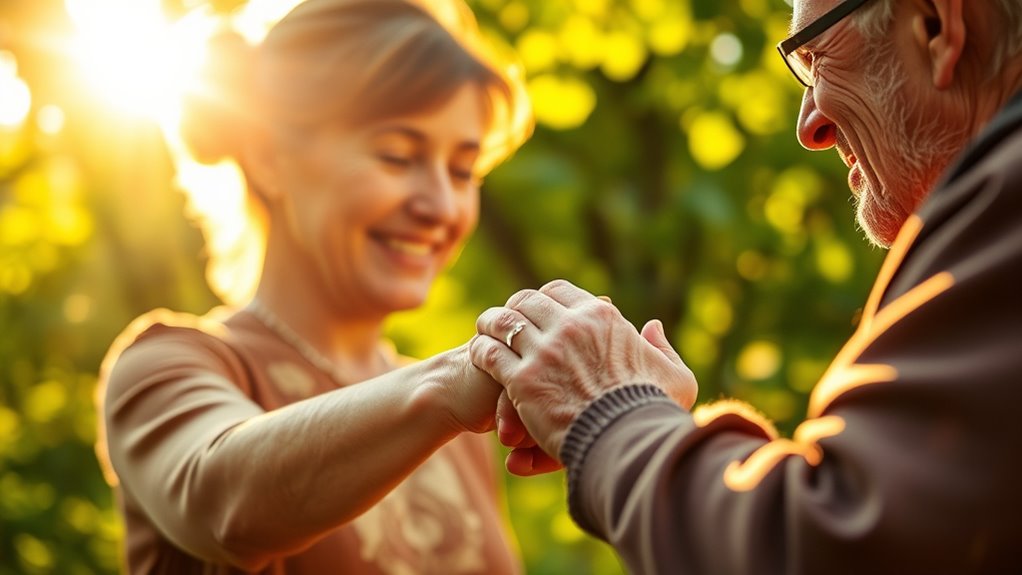Helping others activates your brain’s reward system, releasing feel-good chemicals like dopamine and oxytocin, which strengthen neural pathways linked to happiness and trust. It enhances empathy by engaging specific brain regions, such as the anterior insula and cingulate cortex, fostering deeper social bonds. Repeated acts boost brain plasticity, improving emotional resilience and well-being over time. To discover how these neural changes can become lasting, explore how kindness rewires your brain for a healthier, happier life.
Key Takeaways
- Acts of kindness activate reward circuits, releasing feel-good chemicals like dopamine and oxytocin, reinforcing compassionate behaviors.
- Helping others enhances neural connectivity between empathy regions such as the anterior insula and anterior cingulate cortex.
- Repeated altruistic acts promote neural plasticity, strengthening social bonding pathways and emotional resilience over time.
- Kindness practices can rewire brain circuits, making compassionate responses more automatic and genuine through neuroplastic changes.
- Altruists show increased activity in empathy-related brain areas, supporting effortless, intuitive kindness and social bonding.
The Brain’s Reward System and Acts of Kindness

When you perform acts of kindness, your brain’s reward system kicks into gear, reinforcing those behaviors and encouraging you to repeat them. This process involves neural synchronization, where different parts of your brain coordinate to promote positive feelings. As you help others, your emotional regulation improves because your brain associates kindness with relief from stress and negative emotions. The release of feel-good chemicals like dopamine strengthens these neural pathways, making kindness more natural over time. This feedback loop motivates you to continue caring for others, creating a cycle of compassion and emotional balance. Additionally, engaging in kind acts can enhance your overall well-being by activating the same reward circuits involved in pleasure and motivation homeostasis, reinforcing behaviors that benefit both you and those around you. Furthermore, research from the 16PF personality traits highlights how individual differences can influence responses to acts of kindness, shaping the way your brain processes these positive experiences. Recognizing neural mechanisms involved in kindness can deepen your understanding of its profound impact on mental health. A better understanding of brain plasticity reveals how repeated acts of kindness can lead to long-lasting positive changes in your neural pathways.
Oxytocin: The Love Hormone and Its Role in Connection

As acts of kindness activate your brain’s reward system, another key player, oxytocin, is released to deepen feelings of connection and trust. This hormone, often called the love hormone, plays a vital role in bonding behaviors. When you help others or receive kindness, oxytocin release occurs, strengthening social bonds and fostering a sense of safety. It promotes feelings of warmth and attachment, making interactions more meaningful. The more you engage in bonding behaviors, the more oxytocin your brain produces, reinforcing positive social connections. This hormone not only enhances your emotional well-being but also encourages continued acts of kindness. By understanding oxytocin’s role, you can see how helping others naturally nurtures trust and intimacy, creating a cycle that benefits both your brain and your relationships. Additionally, engaging in social activities that involve emotional bonding can further stimulate oxytocin production. Incorporating gears and mechanical elements into your environment can also stimulate feelings of curiosity and engagement, further enriching social interactions and promoting vibrational harmony. Recognizing the neuroscience behind kindness can motivate more intentional and impactful acts of compassion.
How Empathy Shapes Neural Pathways

Empathy actively shapes your brain’s neural pathways by engaging specific regions responsible for understanding and sharing others’ feelings. As you practice empathy, your brain undergoes neural plasticity, allowing these pathways to strengthen and adapt. This development isn’t static; it evolves with your experiences, making you more attuned to others over time. When you empathize, mirror neuron systems activate, helping you simulate and understand emotions. Repeated acts of empathy enhance connectivity between brain areas like the insula and anterior cingulate cortex, reinforcing these pathways. This neural refinement not only improves your capacity for compassion but also makes it easier to respond empathetically in future situations. Additionally, engaging in acts of kindness can further promote neural plasticity, encouraging your brain to adapt and develop in positive ways. Studies show that consistent practice of empathy can lead to lasting changes in brain structure, emphasizing the potential for brain development through social behaviors. In essence, empathy development rewires your brain, creating a more responsive and compassionate neural network.
The Impact of Giving on Brain Plasticity

Giving activates the brain’s reward system, triggering the release of feel-good chemicals like dopamine and oxytocin. This response encourages neural adaptation, making your brain more responsive to prosocial behaviors over time. When you help others regularly, your brain strengthens existing synapses and creates new connections related to kindness and generosity. This synaptic strengthening enhances your capacity for empathy and social bonding, reinforcing the positive effects of giving. As your neural circuits adapt, you may notice increased resilience and emotional well-being. The brain’s plasticity allows these changes to become more ingrained, shaping your future responses to social situations. Fundamentally, giving doesn’t just feel good in the moment—it rewires your brain for more compassionate, connected behavior. neural adaptation is a key process that underpins these lasting changes in brain structure and function.
Compassion and Stress Reduction in Neural Circuits

Compassion actively engages neural circuits that help regulate stress, leading to measurable reductions in the body’s stress response. When you practice kindness, your brain promotes emotional regulation by enhancing neural synchronization across stress-related regions. This coordination calms the amygdala, reducing anxiety, while strengthening prefrontal areas that manage emotional control. The result is a more balanced stress response, making you more resilient. The table below highlights key neural mechanisms involved:
| Neural Mechanism | Effect on Stress |
|---|---|
| Neural synchronization | Promotes emotional regulation |
| Activation of prefrontal cortex | Enhances emotional control |
| Amygdala inhibition | Reduces anxiety and fear |
| Oxytocin release | Fosters social bonding |
| Brain connectivity | Strengthens resilience |
Furthermore, engaging in acts of kindness has been shown to neuroplasticity by reinforcing positive neural pathways associated with social connection and emotional well-being. This ongoing process supports long-term mental health and emotional growth.
Mirror Neurons and the Experience of Helping Others

When you observe someone helping others, mirror neuron functioning kicks in automatically, creating a shared internal experience. These neurons activate not only when you perform an action but also when you see others helping, enabling you to feel what they’re experiencing. This neural response underpins helping behavior modeling, as your brain mimics the actions and emotions you witness. It’s like your brain is practicing kindness by simulating the act internally, making helping feel more natural. Mirror neurons strengthen social bonds by fostering empathy and understanding, encouraging you to act altruistically. This automatic mirroring helps you connect deeply with others’ experiences, reinforcing a cycle of compassion and kindness. Additionally, understanding store hours can help you plan your interactions and social engagements more effectively, enhancing your ability to connect with others in various contexts. Fundamentally, your brain’s mirror neuron system makes helping others an intuitive and emotionally resonant process.
Long-Term Brain Changes From Consistent Altruism

When you practice consistent altruism, your brain forms stronger social bonds that boost your sense of connection. It also builds emotional resilience, helping you handle stress and adversity more effectively. Over time, these actions promote brain plasticity, allowing your neural networks to adapt and grow stronger. Additionally, engaging in altruistic behaviors can positively influence your emotional well-being and overall mental health. The development of durable and reliable portable camping gear can further support mental well-being by reducing stress during outdoor adventures, fostering a sense of preparedness and confidence.
Strengthening Social Bonds
Engaging in consistent acts of altruism can lead to lasting changes in your brain that strengthen social bonds over time. When you help others regularly, your brain enhances its emotional regulation skills, making it easier to navigate social situations calmly and empathetically. This consistent kindness also improves your social cognition, sharpening your ability to understand others’ feelings and perspectives. As a result, you become more attuned to social cues and better at forming meaningful connections. These neural adaptations reinforce positive interactions, deepening trust and mutual support. Over time, your brain becomes wired to prioritize social harmony, making kindness a natural part of your relationships. Additionally, understanding the neuroscience of kindness can help you appreciate how these changes promote long-term social bonds. Recognizing how brain plasticity enables these adaptations sheds light on the capacity for personal growth through altruism. The ongoing practice of kindness leverages neuroplasticity, allowing your brain to continually adapt and strengthen social pathways. This long-term change fosters stronger, more resilient social bonds that enrich your personal and communal life. Moreover, cultivating empathy through acts of kindness can further enhance these neural benefits, creating a positive feedback loop that sustains meaningful connections.
Enhancing Emotional Resilience
Consistently practicing altruism can lead to profound long-term changes in your brain that boost emotional resilience. When you regularly help others, your brain strengthens pathways involved in emotional regulation, making it easier to manage your feelings during stressful situations. Acts of kindness promote the release of neurotransmitters like oxytocin and endorphins, which enhance your mood and reduce anxiety. Over time, this builds a more resilient mind, better equipped to handle adversity. Regular altruistic behavior also decreases activity in the amygdala, the brain’s fear center, helping you respond to stress more calmly. By cultivating kindness consistently, you reinforce neural circuits that support emotional stability, empowering you to face challenges with greater confidence and less emotional reactivity.
Promoting Brain Plasticity
Regular acts of kindness don’t just influence your immediate mood—they also induce lasting changes in your brain’s structure. Consistently practicing altruism promotes neurogenesis enhancement, encouraging the growth of new neurons, especially in areas linked to empathy and social bonding. It also drives synaptic remodeling, strengthening connections between neurons and optimizing neural pathways involved in compassion and reward processing. Over time, these changes enhance your brain’s plasticity, making it more adaptable and resilient. This means your brain becomes better equipped to handle stress, foster positive relationships, and maintain emotional balance. By regularly helping others, you’re not only improving their lives but also actively shaping your brain for long-term mental health and cognitive flexibility.
The Link Between Kindness and Mental Health

Research shows that kindness can markedly boost mental health by reducing stress and increasing feelings of happiness. When you engage in kind acts, your brain releases feel-good chemicals, enhancing emotional regulation and fostering cognitive flexibility. This helps you respond more adaptively to life’s challenges. Here are three ways kindness benefits your mental health:
- Reduces stress by lowering cortisol levels.
- Enhances emotional regulation through positive social interactions.
- Boosts cognitive flexibility by encouraging open-mindedness and resilience.
Neural Differences Between Altruists and Non-Altruists

You’ll notice that altruists show different brain activation patterns compared to non-altruists, especially in areas linked to empathy and social processing. Their reward systems light up more strongly when they help others, reinforcing generous behavior. Additionally, connectivity between empathy-related regions tends to be more robust in altruists, supporting their compassionate actions.
Brain Activation Patterns
Altruists and non-altruists show distinct patterns of brain activation when engaging in prosocial behavior. You’ll notice that altruists tend to activate specific regions more efficiently, demonstrating superior neural efficiency. Consider these key differences:
- Increased activity in the anterior insula, linked to emotional regulation and empathy.
- Greater engagement of the temporoparietal junction, involved in perspective-taking.
- Reduced activation in areas associated with emotional regulation effort, indicating effortless compassion.
These patterns suggest that altruists process others’ needs more intuitively, requiring less cognitive effort. Their brains are wired for emotional regulation, making prosocial actions feel more natural. This neural efficiency helps foster genuine kindness, reinforcing the connection between brain activation and altruistic behavior.
Reward System Engagement
When engaging in prosocial acts, altruists show heightened activity in the brain’s reward system compared to non-altruists, reinforcing their motivation to help others. This increased neural activation reflects neural adaptation, where repeated acts of kindness strengthen the pathways involved in reward processing. As a result, altruists experience enhanced cognitive benefits, such as greater emotional regulation and positive outlooks. These neural differences make helping others feel more rewarding, fueling ongoing prosocial behavior. Non-altruists may lack this heightened reward response, which can reduce motivation to engage in kindness. Over time, the brain’s reward system adapts to support altruistic actions, making kindness a more automatic, fulfilling part of daily life. This neural engagement underscores how helping others can reshape your brain’s reward circuitry for the better.
Empathy-Related Connectivity
Have you ever wondered what distinguishes the brains of altruists from those of non-altruists? It all comes down to empathy-related connectivity, which influences social bonding. Research shows that altruists display stronger neural links between empathy regions, such as the anterior insula and the anterior cingulate cortex. This connectivity:
- Enhances their ability to understand others’ emotions deeply
- Fosters stronger social bonds through shared emotional experiences
- Promotes compassionate responses in social situations
This heightened empathy-related connectivity makes it easier for altruists to connect on a neural level, strengthening social bonds and encouraging selfless behaviors. Essentially, their brains are wired to prioritize social connection and empathy, reinforcing their altruistic tendencies.
Practical Ways to Foster Brain-Enhancing Compassion

Practicing simple, everyday actions can markedly boost your brain’s capacity for compassion. Engaging in consistent kindness interventions encourages neural adaptation, strengthening the brain circuits involved in empathy and altruism. You can start by mindful acts like smiling at others, offering genuine compliments, or volunteering your time. Regularly performing these actions rewires your brain, making compassionate responses more automatic over time. Additionally, practicing loving-kindness meditation fosters positive neural changes, enhancing your ability to feel connected to others. Keep in mind that small, intentional steps compound, gradually building a more compassionate brain. By actively choosing kindness, you support neural adaptation, which helps cultivate a more empathetic, caring mindset in daily life.
Frequently Asked Questions
Can Practicing Kindness Actually Increase Brain Volume Over Time?
Practicing kindness can indeed lead to neuroplasticity enhancement and brain volume growth over time. When you regularly help others, your brain forms new neural connections, strengthening areas linked to empathy and reward. This activity promotes positive brain changes, encouraging growth in regions associated with social bonding and emotional regulation. So, by choosing kindness consistently, you actively support your brain’s development, making it healthier and more resilient long-term.
Are There Genetic Factors That Influence Someone’s Propensity for Altruistic Behavior?
Genetic predispositions and heritability estimates suggest that your tendency toward altruistic behavior can be influenced by genetics. While environment plays a role, studies show that about 30-50% of altruism variance may stem from genetics. This means your innate tendencies, shaped by heritability, can make you more naturally inclined to help others. However, conscious choices and experiences still considerably shape your altruistic actions over time.
How Quickly Can Neural Changes From Acts of Kindness Be Observed?
Neural plasticity allows you to observe immediate effects from acts of kindness. When you help others, your brain quickly responds, releasing feel-good chemicals like oxytocin and endorphins. These immediate effects strengthen neural pathways associated with empathy and social connection. While long-term changes develop with repeated kindness, you can experience positive neural shifts almost instantly, highlighting how your brain adapts rapidly through acts of compassion.
Does Kindness Training Benefit Individuals With Mental Health Disorders Differently?
Did you know that kindness training can boost emotional resilience by up to 30%? If you have a mental health disorder, practicing kindness might help improve your social connectedness and reduce feelings of isolation. This benefits you differently because it strengthens neural pathways associated with positive emotions. By fostering these connections, kindness training can be a powerful tool for managing mental health, making you feel more supported and resilient in challenging times.
What Role Do Cultural Differences Play in the Brain’s Response to Altruism?
You might notice that cultural norms influence how your brain responds to altruism. Different cultures emphasize various social behaviors, shaping your neural pathways through brain plasticity. When you engage in helping others within your cultural context, your brain adapts, reinforcing these altruistic responses. So, cultural differences can markedly impact how your brain processes kindness, making your altruistic actions more intuitive or socially reinforced depending on your cultural background.
Conclusion
As you practice kindness, imagine your brain blooming like a vibrant garden, each act planting seeds of connection and compassion. With every helping hand, you strengthen neural pathways that brighten your outlook and soothe stress. Over time, these moments become rooted deep within, transforming your mind into a sanctuary of empathy and joy. Embrace this journey, knowing that each act of kindness reshapes your brain, creating a brighter, more compassionate you.









